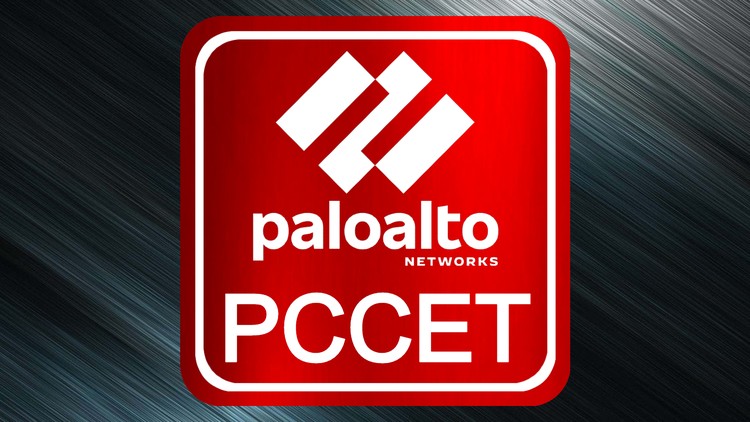Palo Alto Networks Cybersecurity PCCET Practice Exams 2025
Palo Alto Networks Cybersecurity Entry level (PCCET) Practice Exam / Test question with latest simulations #UNOFFICIAL#

2
students
350 questions
content
Jan 2025
last update
$19.99
regular price
Why take this course?
为了帮助您准备Palo Alto Networks Certified Cybersecurity Entry-Level Technician (PCCET)认证,我将根据您提供的内容概述和解释各个部分。以下是对您分类的内容的详细说明:
1. Endpoint Security and Management
- Managing Wireless Devices vs. Other Endpoints: Wireless devices differ from other endpoints in terms of connectivity, security risks (such as rogue access points), and management policies that cater to mobility and diverse operating systems.
- Identity and Access Management (IAM): IAM is a framework of policies and technologies for ensuring that only authorized individuals have access to distinct parts of IT systems and data. It's crucial for maintaining the integrity and confidentiality of data.
- NGFWs Integration: Next-Generation Firewalls (NGFWs) are integrated with the cloud, networks, and endpoints to provide advanced security capabilities such as threatening prevention, application control, SSL decryption, and so on, to protect against sophisticated cyber threats.
- App-ID, User-ID, Content-ID: These are features of Palo Alto Networks firewalls that allow for the identification of applications (App-ID), users (User-ID), and content (Content-ID) beyond just IP addresses and ports. This enables more effective security policies and threat prevention.
- Palo Alto Networks Firewall Subscription Services: These services provide regular updates, threat intelligence, and new features to keep the firewall infrastructure up to date against evolving threats.
- Network Security Management (NSM): NSM involves the management of IT security resources across an entire network. It helps organizations detect, analyze, and respond to security incidents to protect critical assets, operations, and data.
2. Cloud Technologies
- NIST Cloud Service Models: The National Institute of Standards and Technology (NIST) defines four cloud service models: Infrastructure as a Service (IaaS), Platform as a Service (PaaS), Software as a Service (SaaS), and Desktop as a Service (DaaS).
- Cloud Security Challenges: These include data breaches, insecure APIs, account hijacking, data loss, and insufficient change management.
- Virtualization in Cloud Computing: Virtualization allows multiple virtual systems to share the same physical hardware, improving resource utilization and reducing costs.
- Containers in Application Deployment: Containers package applications and their dependencies into a single unit, making them easier to deploy and maintain across different cloud environments.
- Serverless Computing: Serverless computing abstracts server management and allows developers to build and run applications without worrying about the underlying infrastructure.
- DevOps: DevOps is a set of practices that combines software development (Dev) and IT operations (Ops) to shorten the development lifecycle and provide continuous delivery with high software quality.
- DevSecOps: This integrates security processes into DevOps practices, ensuring security is not an afterthought but part of the software development lifecycle.
- CI/CD Pipeline: Continuous Integration (CI) and Continuous Delivery (CD) are key elements in Agile and DevOps practices, enabling frequent code integration and automatic code deployment to production.
- Governance and Compliance for SaaS Applications: This involves ensuring that the use of Software as a Service adheres to regulatory requirements and company policies.
- Cost of Maintaining a Physical Data Center: Physical data centers require significant capital investment, operational expenses, and ongoing management compared to cloud solutions.
- Data Center Security Weaknesses: Traditional data centers often face challenges such as limited visibility across virtualized environments, difficulties in implementing consistent security policies, and complex physical and network infrastructures.
- East-West vs. North-South Traffic: East-west traffic refers to communication within a data center or cloud environment, while north-south traffic is between different data centers or the internet.
- Four Phases of Hybrid Data Center Security: These typically include identity and access management, data encryption, monitoring and analytics, and security architecture design.
- Cloud-Native Security Platform: This platform is designed to secure applications on a native cloud infrastructure with capabilities tailored for cloud-native workloads.
- Cortex Cloud Application Security: Provides comprehensive, cloud-native application protections across every stage of the development lifecycle.
- Secure Access Service Edge (SASE): SASE is an emerging architecture that delivers cloud-centric network and security services tailored to the needs of digitally transforming organizations.
- SASE Components: SASE combines WAN capabilities, such as SD-WAN, with network security functions, including firewall, VPN capabilities, endpoint security, intrusion prevention systems (IPS), and cloud access security brokers (CASB).
3. Preparing for the PCCET Exam To prepare for the PCCET exam, you should study the above topics, understand the principles of Palo Alto Networks firewalls, and gain familiarity with the latest cybersecurity threats anddefenses. Practice using Palo Alto Networks firewall solutions, familiarize yourself with the deployment scenarios, and take advantage of the official training materials provided by Palo Alto Networks to solidify your understanding before taking the exam.
Loading charts...
6202385
udemy ID
24/09/2024
course created date
05/10/2024
course indexed date
Bot
course submited by